Iconic Bulguksa Temple
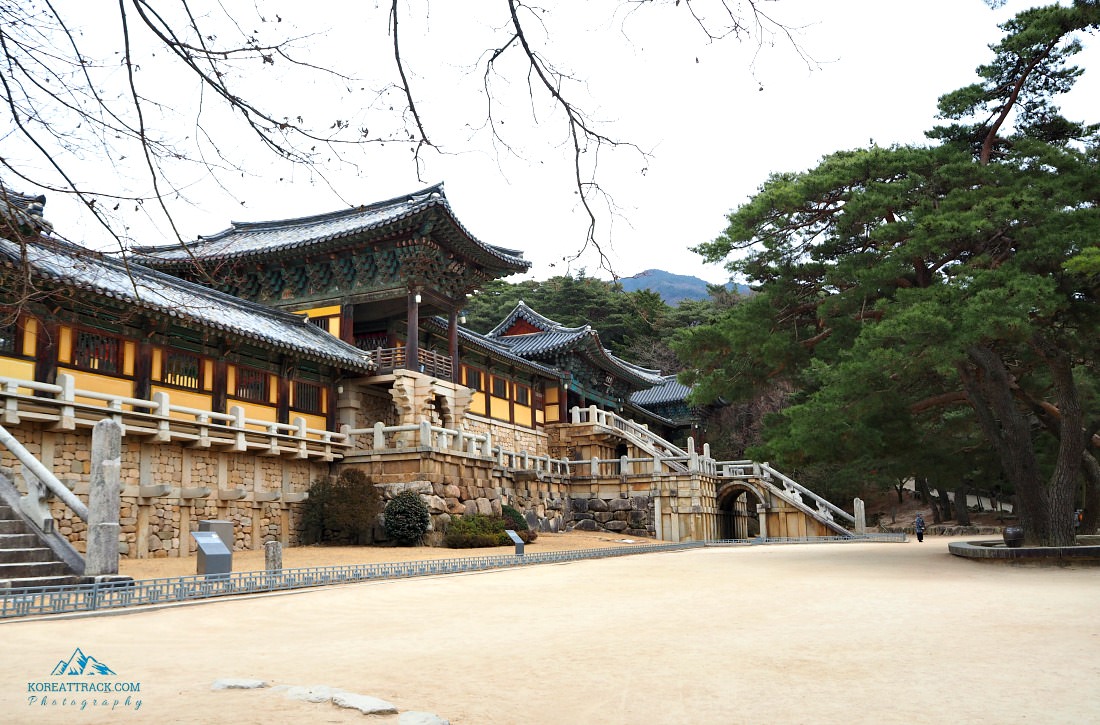 Side view of the main entrance to Bulguksa with Cheongungyo Bridge-Baegungyo Bridge in this view
Side view of the main entrance to Bulguksa with Cheongungyo Bridge-Baegungyo Bridge in this viewIntroduction
Bulguksa Temple is one of the most famous Buddhist temple complexes in South Korea. It is located on the slopes of Mount Toham, near Gyeongju City.
The temple complex was constructed in 528 during the Silla Kingdom and is one of South Korea’s National Treasures. The two main structures at Bulguksa are Dabotap and Seokgatap, two iconic stone pagodas that stand side by side to symbolize two gods protecting Buddhism.
Other notable features at the temple complex include Cheongungyo and Baegungyo Bridges, a pair of stone bridges spanning a small pond as well as numerous intricately carved statues depicting various Buddhist figures. All these features make Bulguksa Temple one of South Korea's most popular tourist destinations.
Bulguksa Temple dates back to the 8th century and is considered a national treasure of South Korea. The temple complex is home to seven National Treasures of South Korea and has been designated as a UNESCO World Heritage Site.
It is one of the most visited tourist attractions in the country and offers visitors a look at traditional architecture, sculptures, and colorful artwork that reflect the culture and beliefs of Korean Buddhism.
The temple complex includes two main courtyards, surrounded by stone pathways lined with carved pagodas, bell-shaped stupas, serene ponds, lush gardens and various other buildings. Visitors can also explore hidden caves filled with secrets from the past.
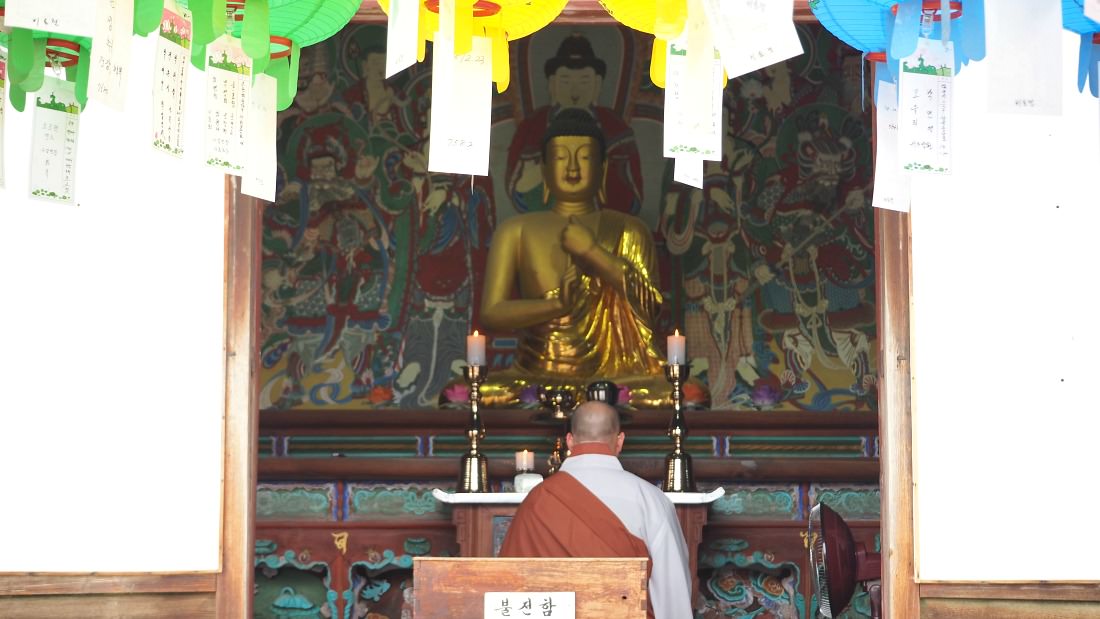 A view of Vairocana Buddha inside a temple
A view of Vairocana Buddha inside a templebulguksa temple's treasures
Bulguksa Temple in Gyeongju is one of the most celebrated and visited temples in the whole of South Korea.
Briefly, Bulguksa Temple has a very long history of ups and downs. The temple area was constructed during the Shilla Period in 751.
Traveling to Bulguksa and exploring its beautiful and serene environment is quite easy. You only need to get to Gyeongju City (or nearby places—Ulsan, Busan, etc) to access transports going to Bulguksa.
Personally, one of the reasons why I especially traveled and explored Bulkgusa is that it is worth my time and resources. The whole place was totally amazing, and I would never hesitate to come again… And again!
Below are the main features and are highly recommended to see and spend moments on…
never to miss features
Cheongungyo Bridge--Baegungyo Bridge
These two bridges connect two important structures in the temple—the Jahamun Gate that leads to Daeungjeon Hall (main hall of the temple area).
They are not merely functioning as bridges per se. But they have symbolic functions as well: they symbolize a bridge that links the people of the underworld and the world of Buddha above.
The bridge is believed to be the path for the spirits of the dead to reach Nirvana, and it also stands for hope that those who cross it will find peace and enlightenment. As such, the Cheongungyo Bridge has become a popular spot for people who wish to find solace in their hearts.
In addition to its spiritual significance, Cheongungyo Bridge also serves a practical purpose. During the rainy season, it prevents flooding and provides an alternate route for visitors to access Daeungjeon Hall.
In Korean folklore, the Baegungyo Bridge is believed to be haunted by a spirit known as “Kumiho”. Some visitors report feeling a strong presence around the bridge and visitors are warned to stay away during the night.
Regardless of its mystical connotations, Cheongungyo Bridge is an important landmark in Korean culture and a popular attraction for both locals and tourists alike. This impressive structure is sure to remain a part of Korea’s history far into the future.
For those looking for a place of peace and serenity, Cheongungyo Bridge is the perfect destination. With its majestic architecture and spiritual symbolism, it provides visitors with a tranquil escape from the hustle and bustle of everyday life.
Here they can find solace in their hearts as they take in the beauty of this historic bridge. Whether you are looking for a place of tranquility, or just curious to learn more about Korean history and culture, Cheongungyo Bridge is certainly worth your visit.
As visitors cross this remarkable bridge, they are reminded that Korea’s past is also part of its present and future.
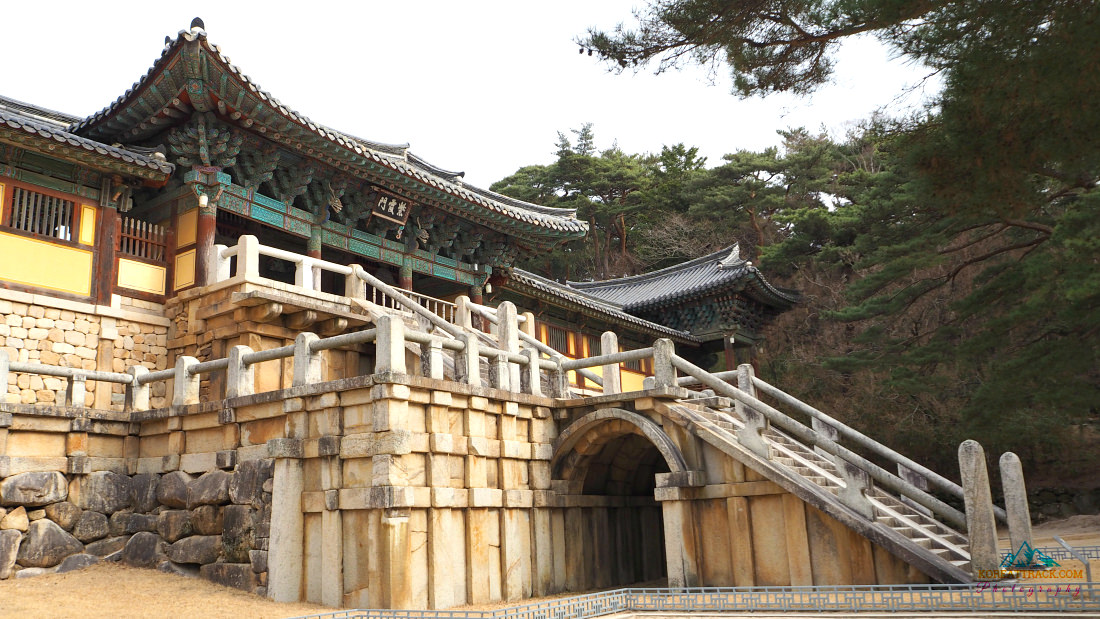 Side view of Cheongungyo Bridge-Baegungyo Bridge of Bulguksa
Side view of Cheongungyo Bridge-Baegungyo Bridge of BulguksaFACT CHECK: These bridges are being replicated and can be seen in Seoul’s National Folk Museum of Seoul. You cannot climb unto these bridges as they are closed, and they are only for the “enlightened ones.”
Beomyeongnu Pavilion--Jwangyeongnu Pavilion
Beomyeongnu Pavilion is a newly-constructed pavilion and a smaller version of the old one. The Jwangyeongju Pavilion is the one situated to the East of Beomyeongnu Pavilion.
They suffered destruction during the end of the Joseon Period but were reconstructed later on. Both pavilions were built in a beautiful, traditional Korean style with red-tiled roofs.
In addition to its historical and cultural significance, Beomyeongnu Pavilion and Jwangyeongnu Pavilion are also known for their beautiful scenery.
A pavilion for Buddhist Scriptures called Gyeongju Pavilion is presumed to be where the scriptures had been kept, but the location of the structure cannot be found.
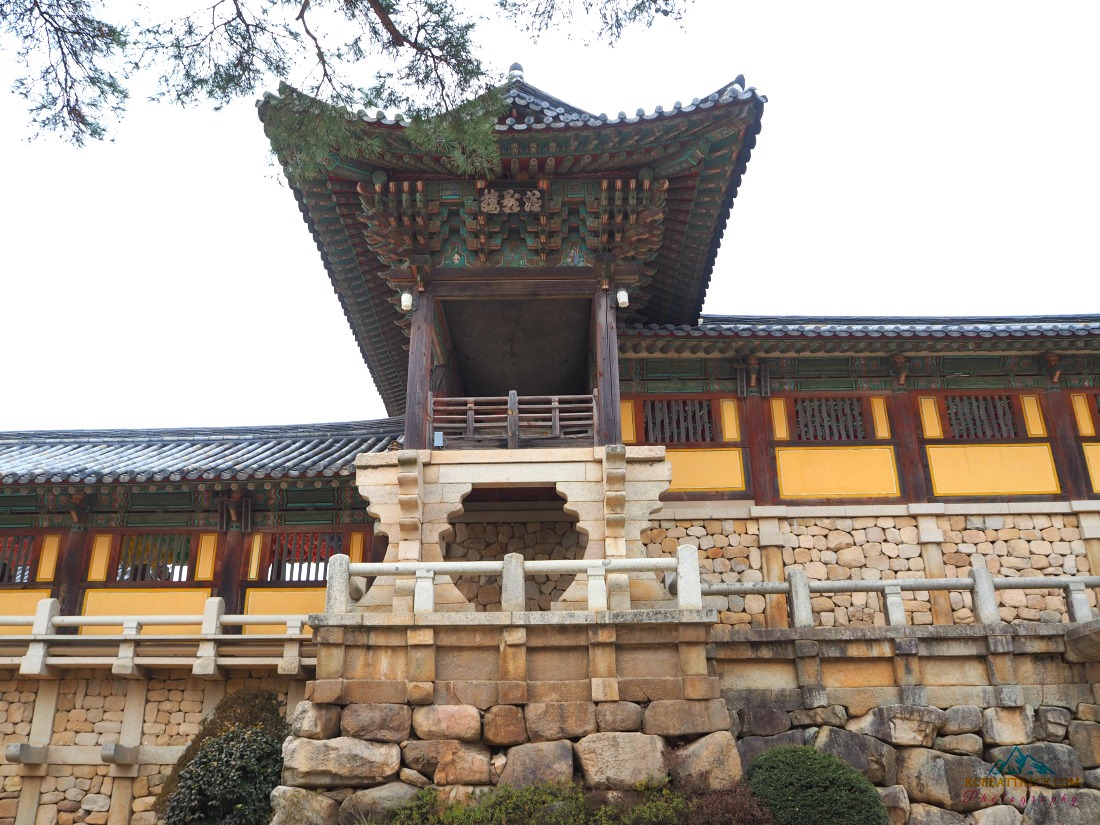 Beomyeongnu Pavilion-Jwagyeongnu Pavilion of Bulguksa. It is visible at the front of the temple site.
Beomyeongnu Pavilion-Jwagyeongnu Pavilion of Bulguksa. It is visible at the front of the temple site.Daeungjeon Hall (Main Religious Activity Hall)
Daeungjeong Hall is where the statue of Sakyamuni Buddha is enshrined and venerated. The hall has a well-preserved stone works, such as the stylobates and lanterns.
The hall is dedicated to the preaching of Buddha's teachings, such as the Four Noble Truths and Eightfold Path. It serves as a place for meditation and reflection, as well as a refuge from the hustle and bustle of everyday life. This is where devotees come to connect with their inner spiritual selves, to find peace and joy within.
The hall is also home to various cultural events and gatherings, such as musical recitals, spiritual discourses, lectures, and other activities that promote Buddhist teachings. Visitors can come to experience the unique atmosphere of Daeungjeon Hall and find their own inner peace.
In addition to its religious significance, Daeungjeon Hall also serves as an important landmark in Korean history. It is a reminder of the importance of religious and cultural heritage, and its influence has extended far beyond Seoul's city limits.
As such, it is a popular destination for sightseers from all around the world. With its grandeur and peacefulness, Daeungjeon Hall stands as a testament to the power of tradition and faith.
No matter what your background, Daeungjeon Hall is a place where visitors can come together to share ideas, meditate on life’s bigger questions, and seek out personal growth. Whether you choose to make this journey alone or take part in one of its many activities.
Also, you can still see the reconstructed architecture and paintings that are preserved and stood through time.
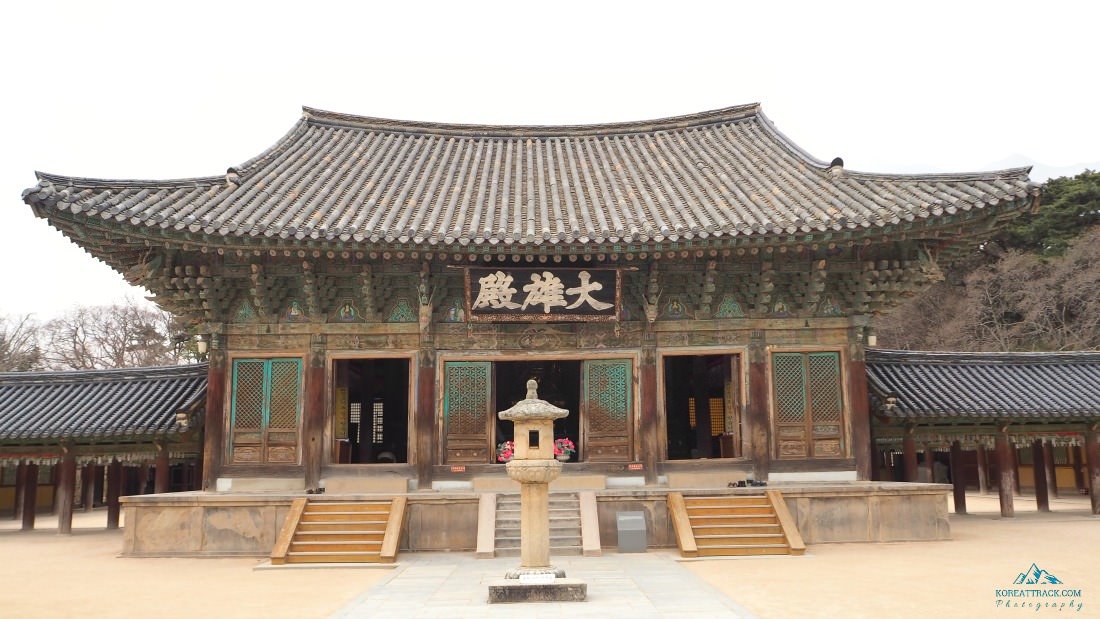 Daeungjeon Hall is the main hall for religious activities at every Buddhist temples.
Daeungjeon Hall is the main hall for religious activities at every Buddhist temples.Museoljeon Hall
Museoljeon Hall is believed to be the oldest structure built in the temple area. Its construction was ordered by King Munmu of Silla Dynasty. The hall contains an image of Buddha and other cultural items such as paintings and books.
Inside, there are 12 statues of monks wearing different types of monks’ clothing from various periods including the Goryeo Dynasty. It is also home to a variety of Buddhist artifacts, including wooden blocks used for printing sutras and lanterns.
The hall is also famous for its magnificent view of Geumgangsan Mountain from the rooftop. It is believed that this mountain was a resting spot for celestial gods and goddesses during the reign of King Munmu.
This makes Museoljeon Hall an important cultural symbol of Korea. The hall has been designated as a National Treasure by the Korean government and is open to visitors year-round.
The hall has been used for various Buddhist lectures including the Lotus Sutra lecture.
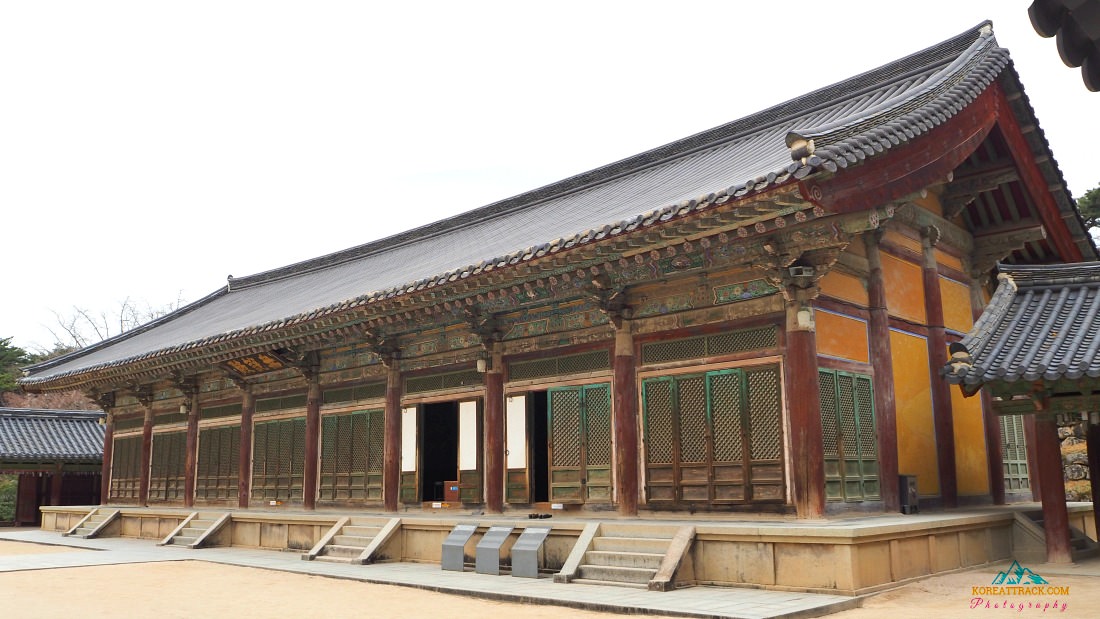 Museoljeon Hall is believed to be the oldest structure in the temple area.
Museoljeon Hall is believed to be the oldest structure in the temple area.Birojeon Hall
Birojeon Hall is a small temple where supplications of the people are being offered—especially offered by a monk.
It is where the statue of Vairocana Buddha is enshrined. The statue is made up of gold and silver. There are also two statues of Amitabha Buddha and Medicine Buddha in the temple.
Birojeon Hall is very popular among Korean Buddhists due to its small size, simplicity and peaceful atmosphere, making it a great place for meditation. It is open all year round and can be visited by anyone.
Visitors can take part in various activities such as chanting, meditating, and praying for health and peace. Birojeon Hall is a great place to visit if you want to learn more about Korean Buddhism and experience a tranquil atmosphere.
Overall, Birojeon Hall is a great place to explore and learn more about the Buddhist culture in South Korea. The serene atmosphere and stunning Buddha statues will surely make it an unforgettable experience!
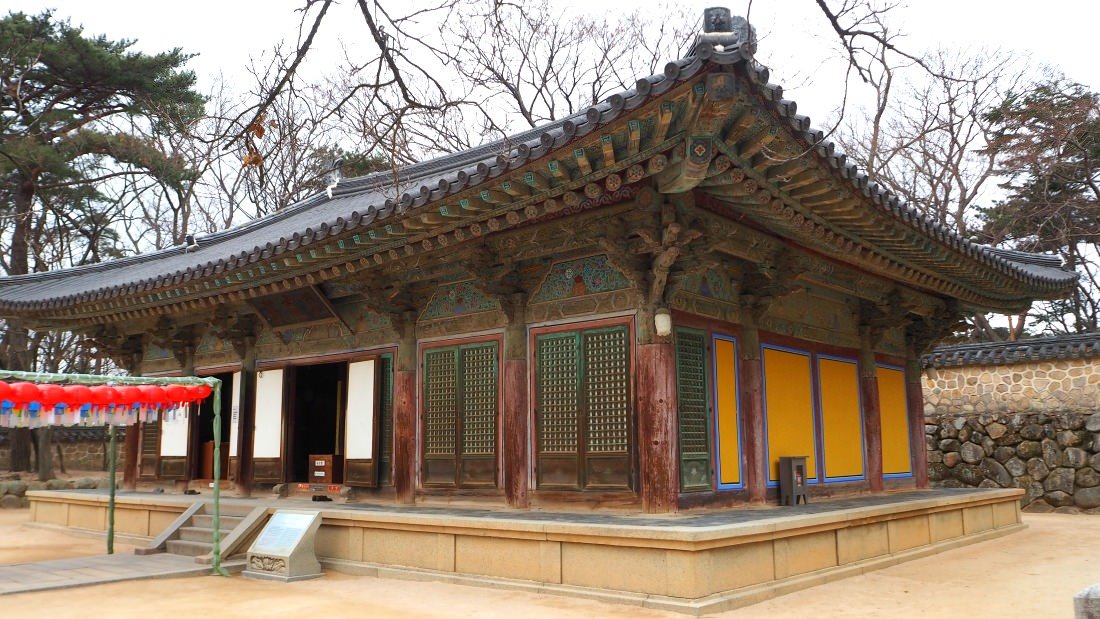 Birojeon Hall houses the statue of the highly venerated statue of Vairocana Buddha.
Birojeon Hall houses the statue of the highly venerated statue of Vairocana Buddha.Gwaneunjeon Hall
It is one of the most important sacred temples in Bulguksa. It shrines the image of Avalokitesvara—the Bodhisattva of Compassion.
Structurally, Gwaneumjeon Hall is rectangular in shape and has three rooms on the front side, three rooms in the back part has four inner columns, and it has a ‘multi-layered quadrangular pyramid style roof.’ The roof itself is adorned with curved tiles and a finial shaped like a lotus flower.
The interior of Gwaneunjeon Hall is decorated with intricate carvings of various Buddhas and Bodhisattvas, as well as guardian deities that are believed to protect the temple from evil forces. Additionally, there's a three-meter-tall wooden statue of Avalokitesvara, the Bodhisattva of Compassion.
Gwaneunjeon Hall has been a place of worship for centuries and is visited by many Buddhists today as they make their pilgrimage to Bulguksa. It's one of the most important places in Gyeongju and provides visitors with a glimpse into its rich history and culture.
Furthermore, it's also an architectural wonder that serves as a reminder of the awe-inspiring feats people achieved in the past.
Visitors to Gwaneunjeon Hall can witness various ceremonies performed by monks throughout the day, such as chanting mantras and offering blessings. They can also explore the many statues that adorn the temple, including those of five mythical kings who were believed to have descended from heaven to guard the temple.
Inside Gwaneunjeon Hall is a statue of King Seondeok, who was a benevolent ruler during his reign in Silla Dynasty. This statue is particularly remarkable because of its intricate details, symbolic meaning and historical importance.
At the entrance of Gwaneunjeon Hall lies a magnificent Bell Pavilion that houses an antique bronze bell. This bell is said to have been cast by King Seondeok himself, creating a unique atmosphere and adding to the temple’s grandeur.
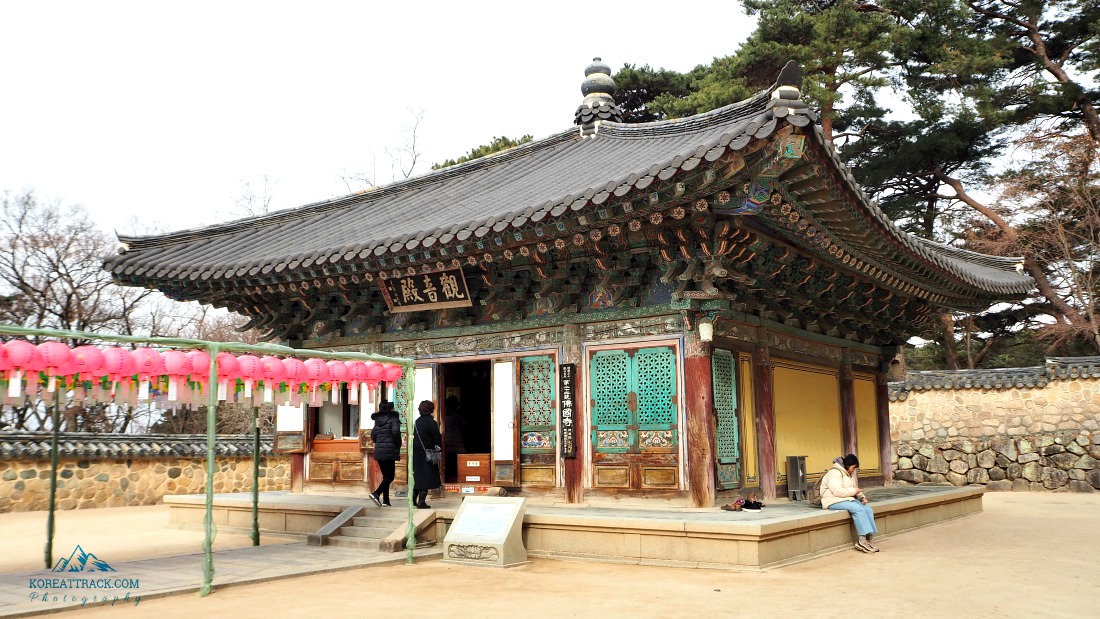 View of Gwaneumjeon Hall
View of Gwaneumjeon HallYeonhwagyo Bridge – Chilbogyo Bridge
Buddhists believe that people who achieved nirvana (enlightenment) can go up and down on it. The bridge is considered an entrance to the spirit world.
Those two bridges, as symbols in Buddhist belief, have been depicted as structures (bridges) at various times and places...
Han River: The two bridges, Yeonhwagyo and Chilbogyo, cross the Han River in South Korea. This bridge is a true symbol of the culture and history of Seoul. It has long been a part of the city's identity and is still used by locals and visitors alike.
King Taejo: The Yeonhwagyo Bridge was built in 1395 AD by King Taejo during the Joseon Dynasty. It has survived centuries of war and unpredictable weather. The bridge is made of granite and decorated with intricate carvings, some depicting dragons and fish.
King Taejong: The Chilbogyo Bridge was built in 1413 AD by King Taejong and is the longest bridge of its kind in South Korea. This bridge is also made out of granite which has been weathered and stained by time. It has many carvings of flowers and animals as well as more modern additions such as street lamps.
The two bridges have become a favorite place for locals and tourists alike to view the city skyline and enjoy walks along the riverbank. Together, these two bridges are symbols of Seoul’s history and culture, serving as reminders of the city’s past and present.
Busan: The Yeonhwagyo Bridge and Chilbogyo Bridge are two of five bridges in Busan, South Korea.
Yeonhwa Bridge is one of the longest bridges in Busan and is situated between Igidae Park and Chilbogyo Bridge. The bridge’s arching design allows for a stunning view of the surrounding landscape, with the distant sea visible across the horizon.
Chilbogyo Bridge was built to connect Igidae Park with Nampodong, one of the oldest markets in Busan. The bridge crosses over Yeonhwagyo Bridge and is also known for its elegant arching form.
The two bridges have been featured in many films, TV dramas, and music videos, providing a stunning backdrop to any scene. Despite their fame, both bridges remain incredibly well-preserved and attract visitors from all over the world. For anyone who wants to experience the beauty of Busan, a visit to Yeonhwa and Chilbogyo Bridges is an absolute must!
One hint: notice the lotus flowers carved in each step of Yeonhwagyo Bridge.
The importance of ‘lotus’ flower in Buddhism is that it is associated with a person’s achievement of enlightenment (blooming lotus flower). Sure, you know this! ^^
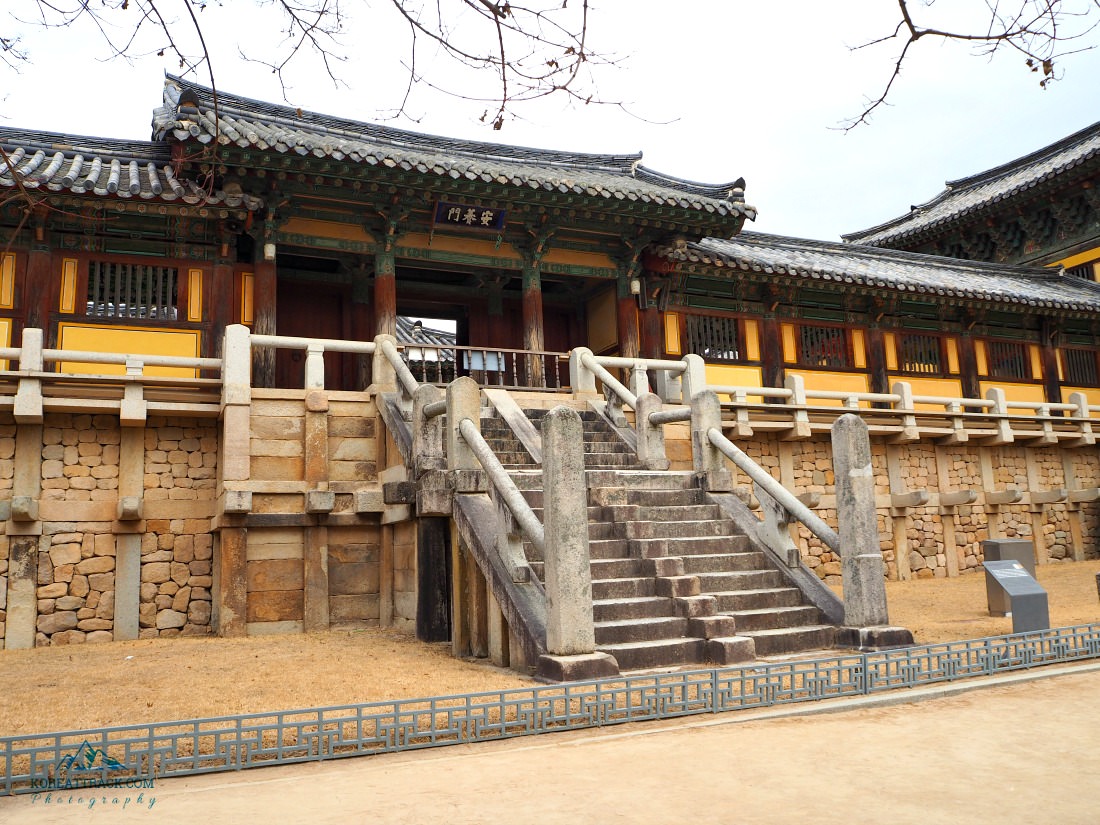 Yeonhwagyo Bridge-Chilbogyo Bridge
Yeonhwagyo Bridge-Chilbogyo BridgeGeungnakjeon Hall
It is a sanctuary of Amitabha Buddha statue. The statue stands 1.66 meters tall. It features a broad shoulder, barrel chest, and slender waistline.
These statue features indicate the way the Unified Shilla period portray Buddha’s characteristics.
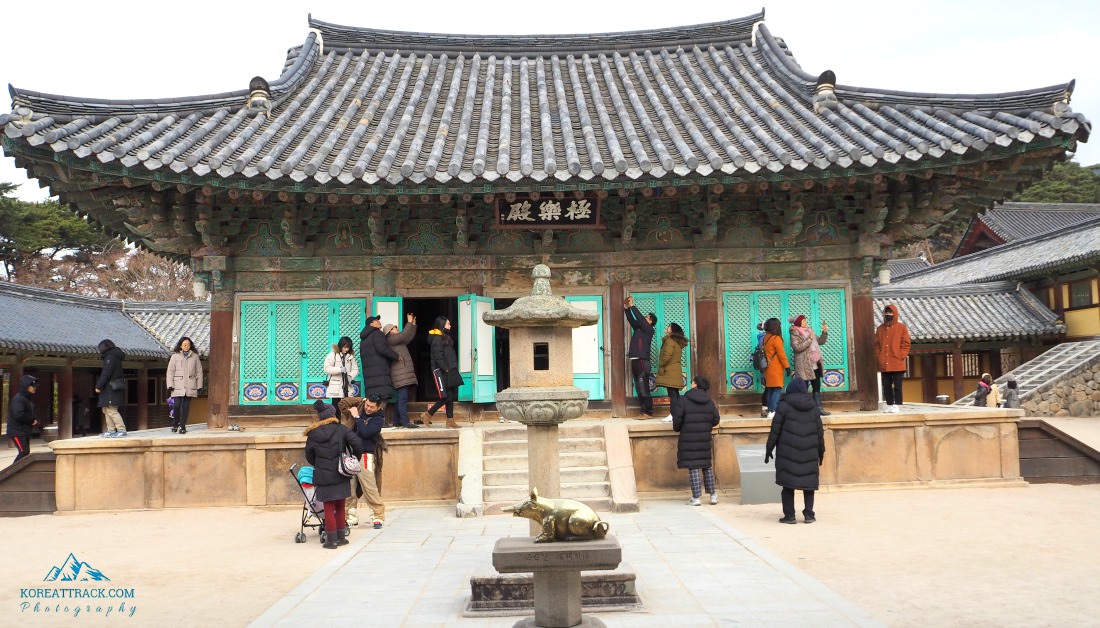 Geungnakjeon Hall
Geungnakjeon Hall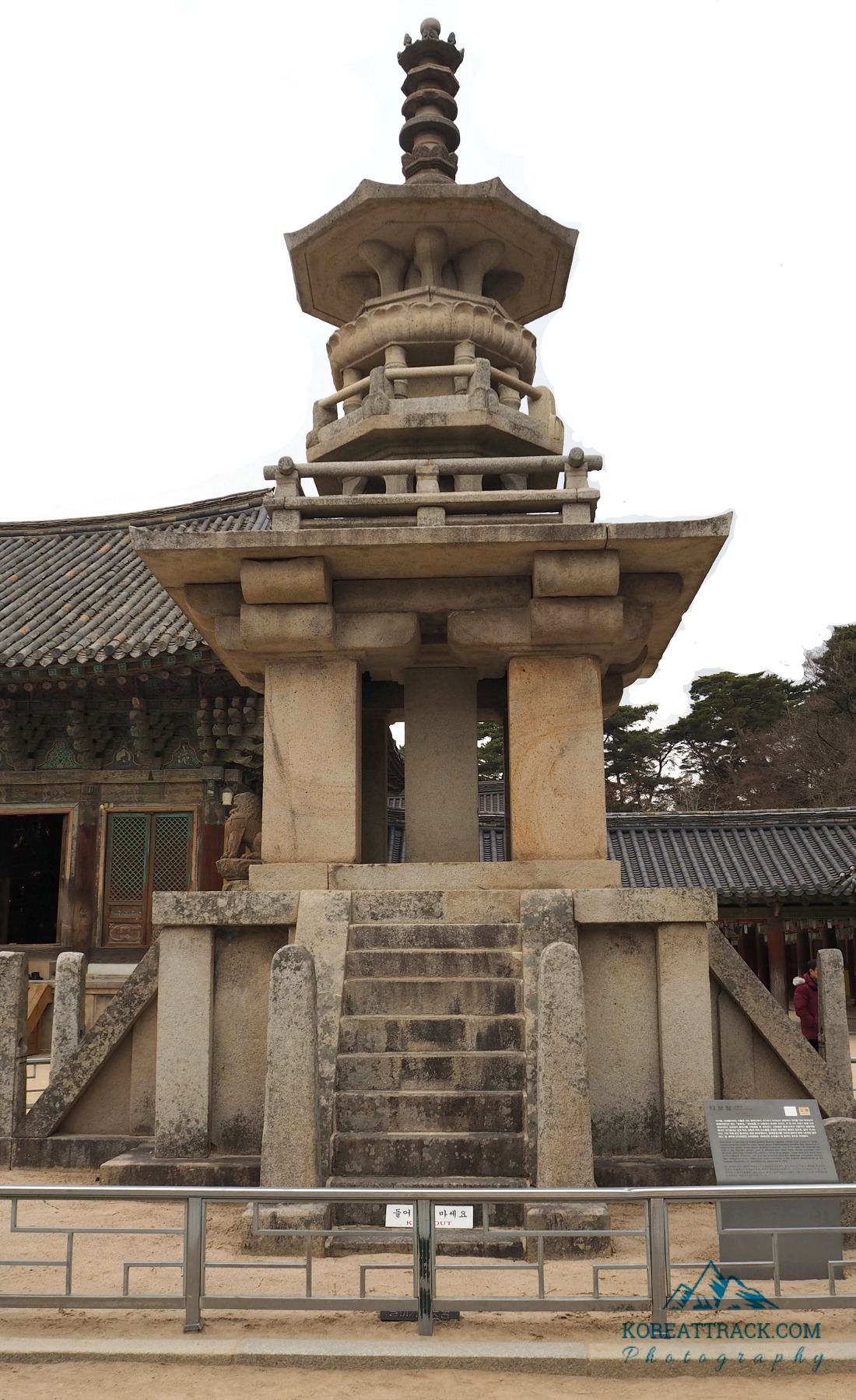
Dabotap Pagoda
This pagoda does not only look complicated but realistically made with much skills and brilliance of its creator.
It is unique if compared with other pagoda structures.
For
one, the pagoda has varied shapes that complement each other: squares,
octagons, circles, round shapes, etc. The length and width and thickness
of each part were perfectly even.
This is a product of the
Unified Shilla’s sense of art in the 8th century.
Sadly, this intricate pagoda also suffered major damages during the Japanese occupation period. However, it was reconstructed to its original form after the liberation.
Seokgatap Pagoda
You can easily find this pagoda in many places in Korea. Yes, it represents the traditional stone pagoda of Korea. Many of these are in this area—Gyeongju
Notice the more complex work on top (head ornament) of the pagoda. Many of such pagodas do not have them as they were either stolen or lost for various reasons.
For this pagoda, its head ornament was also gone before the 16th century but what it has now is modeled after the East and West stone pagoda of Silsangsa Temple in Namwon.
Many calls Seokgatap Pagoda as ‘Muyeongtap,’ which means a “Pagoda of No Shadow.”
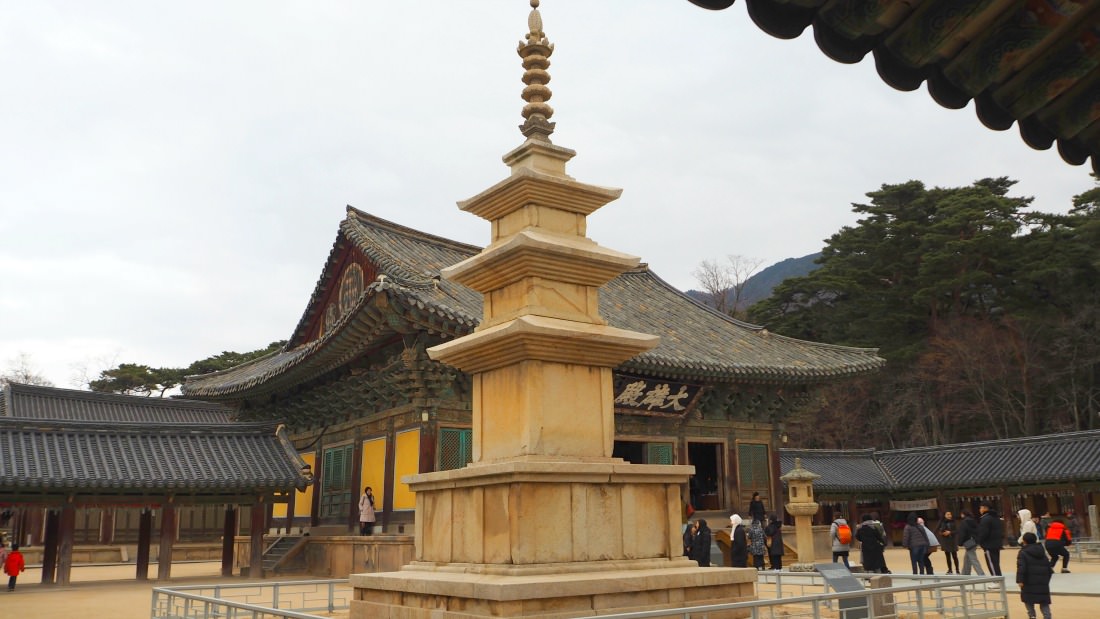 Seokgatap Pagoda
Seokgatap Pagodamore photos
More photos of the beautiful Bulguksa were taken but the ones featured here are especially chosen.
There are several features of this temple that make it truly spectacular. The entire complex is a stunning example of Silla architecture, featuring an upper and lower terrace with multiple stone staircases connecting them.
It also contains seven National Treasures as well as two UNESCO World Cultural Heritages such as Dabotap Pagoda and Seokgatap Pagoda. Bulguksa is also known its exquisite carvings and sculptures, which include the ten Disciples of Buddha and four Deva Kings.
These are just a few of the spectacular features that make Bulguksa such an impressive temple complex. Visit this magnificent relic to experience its beauty first-hand!
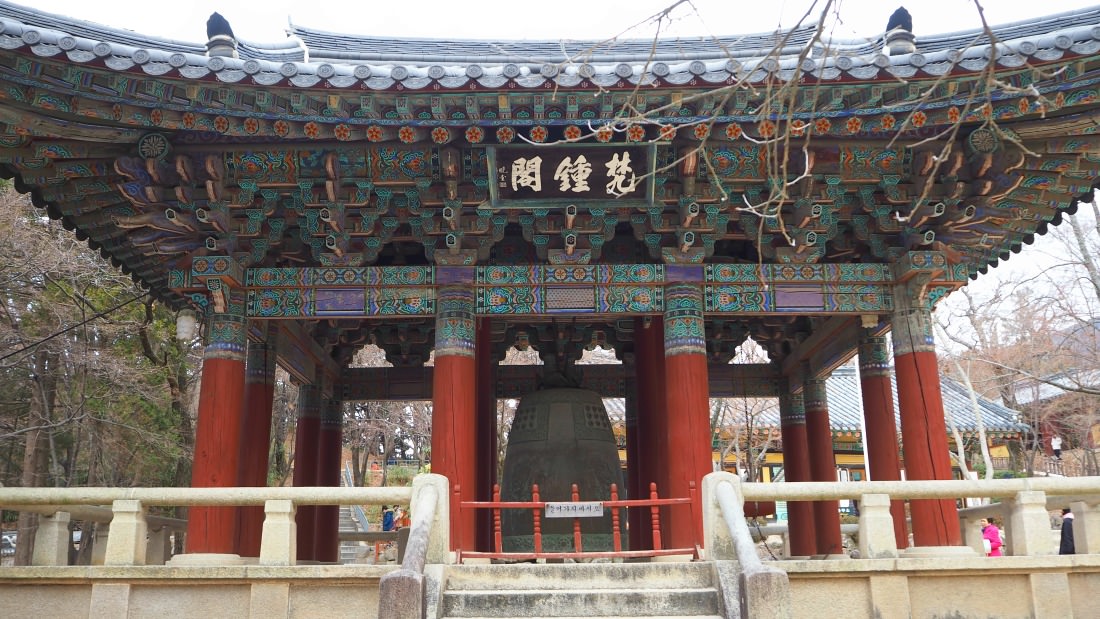 Jonggak or the Big Bell at Bulguksa
Jonggak or the Big Bell at Bulguksa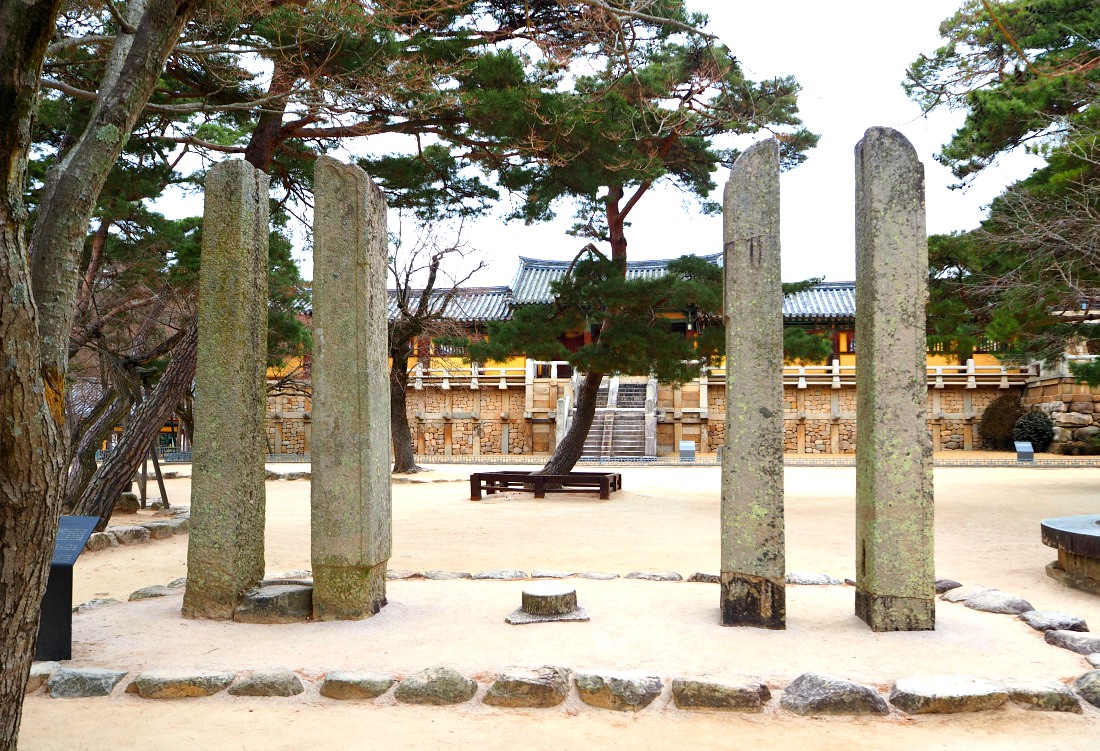 Stone Flagpoles infront of Bulguksa. They are used for religious ceremonies and special events
Stone Flagpoles infront of Bulguksa. They are used for religious ceremonies and special eventsuseful facilities
The following basic facilities could be useful for your visit here…
- Washrooms
- Souvenir Shops
- Drinking Fountain. It is for free, and very refreshing. It is located in front of the temple (to the right).
- Wheelchairs. These are available right before entering the premises of the temple. However, some areas are not accessible because some temples are located much higher than other structures.
impressions
Overall, I really love and cherish my first experience at Bulguksa. I heard so much about it, and it exceeded my expectations. I was expecting much, but still, I was delighted with my experience.
The beauty of the architecture and serene atmosphere complemented each other perfectly. I felt connected to it all, especially the intricate details on the temples. It was a memorable moment for me that I will never forget!
I would highly recommend Bulguksa to anyone looking for an amazing experience with a lot of culture and history. Not only did I get to admire the beauty of the temples, but I also got to learn more about Korean culture and history. The setting was so peaceful and calming that it was easy to focus on what I was seeing and learning.
I'm so glad I had the opportunity to visit Bulguksa. It gave me a better understanding of this incredible country, and it was an experience I will never forget!
I'm sure that you won't regret visiting this wonderful place either. So if you're ever in Korea, make sure to visit Bulguksa Temple - you won't be disappointed.
Bare trees and branches are waiting for the spring to bloom their beautiful flowers and foliage. I would love to revisit this place either during spring or autumn. Cannot wait to do it soon!
Travelling To Bulguksa Temple
As this temple is very popular, various transports travel in this area. You can also take a taxi from Gyeongju Downtown to here.
Intracity Bus
Buses with numbers 10 and 11 pass the Bulguksa’s access road. You can take any of these numbers from the city. If you get off at the Intracity Bus Terminal, go across the road and check out the small waiting area (bus stop).
Take #11 as it takes a shorter time travel than #10.
Express Bus Terminal
Take bus 700 to get to the temple.
Circular Tour Bus is also available at the bus terminal.
Tour Bus and private vehicles are allowed in the area as there is a parking space (not for free, though!).
Other Sites and Places Nearby
There are many places to explore close to the site. The following are my recommendations...
- Seokguram Grotto
- Tohamsan Mountain
- Bulguksa Market
- Shops and Coffee Shops
- Restaurants - local and fusion
where to stay at bulguksa temple area
You can also stay nearby Bulguksa Temple using the cheaper accommodation. There are no big hotels available in the area.
Hanok Experience (Traditional Korean house stay)
Minbak (private house with room for overnight stay)
Hotels
Youth Hostel and other lower-cost accommodations are available in nearby towns.
You can also find a variety of restaurants near Bulguksa Temple to enjoy local cuisine. Many establishments offer traditional meals like bibimbap or jjajangmyeon (black bean sauce noodles).
There are also plenty of cafes and tea houses that have specialty drinks and desserts to try. With its stunning scenery, Bulguksa Temple is a great place to spend some time exploring the area’s rich cultural heritage.
For those looking for an affordable stay near the temple, there are many options available. No matter what your accommodation needs are, you can find something that fits your budget within close proximity to the temple.
Thanks and hope you have a wonderful journey.
- Home
- Temples in South Korea
- Bulguksa Temple
Get Exciting Activities
Book one of our exciting activities today to experience the thrill of a lifetime! Take advantage of this opportunity and secure your spot in advance.
Hotel Map Guide
Find your affordable, accessible, and comfortable hotel in Seoul at Agoda.Com. See the hotel map below...
Hotel Booking Guide
Find affordable and amazing hotels on Agoda.com using the search box below. Book now to enjoy great discounts and save!

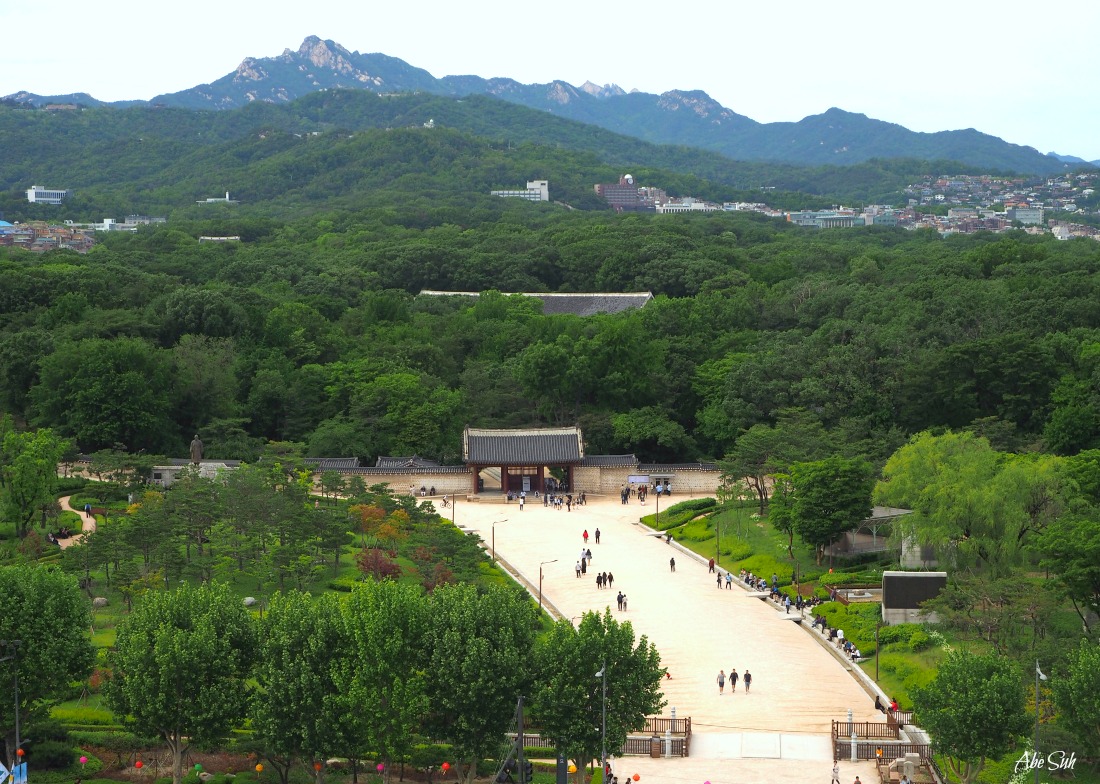





New! Comments
What do you think about this page? Leave me a comment in the box below.